In a nearby neighborhood in the multiverse, I am an astronomer. Astronomy has been a passion of mine ever since I was a child, when I stuck glow-in-the-dark stars to my ceiling in the shape of actual constellations. While I was in college, I studied astronomy as part of my physics degree, and I worked at my school’s observatory, operating a 16-inch research telescope, tutoring astronomy students, and hosting open houses for the public on clear Friday nights. I ultimately decided that I wanted to do something different with my life than research, but, as it turned out, research is a major piece of my life – it just looks a little different than the research I might be doing in a lab or at the base of a telescope.
Once Christian and I knew we would be spending some tourist time in Hawai’i this past January, I put the Mauna Kea observatories at the top of my to-visit list. In retrospect, I probably should have tried emailing some of the university researchers directly to ask for the chance to meet them and see one of these behemoths up close, but, as I’ve mentioned several times in talking about the weeks leading up to this trip, life threw curves, and it was about all I could do to pack my clothes and make my flight. In the end, we did make it onto a tour of the summit at sunset – and learned that when it comes to the relationship between Hawai’i and astronomy… it’s complicated.
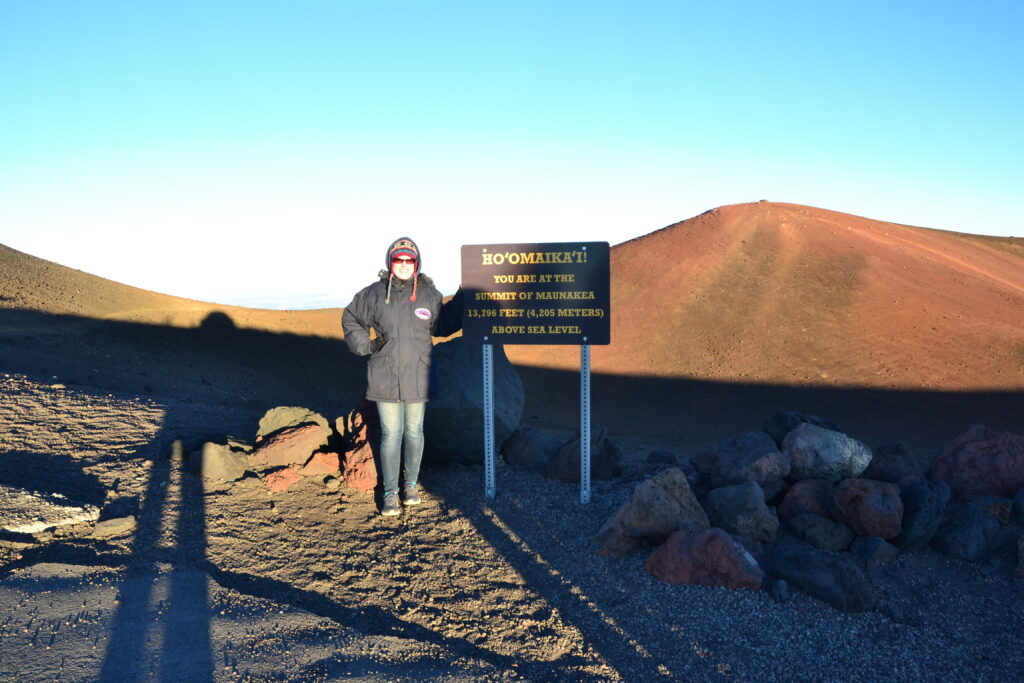
Photo credit: random, kind stranger
Above the Clouds
The island of Hawai’i – called “The Big Island” by most Americans – is home to lush natural beauty, stark fields of volcanic rock, fire goddess Pele (who settled in rumbly Kilauea after her long journey across the ocean), [1] and notably fewer people per square mile than the other islands we visited on this trip, which was a welcome change. Indeed, we leaned into the opportunity and booked a room at a sustainable farm south of Hilo (on the less touristy side of the island). From Kona, where we flew in, it was a two-plus hour drive to our destination, and it was already nightfall by the time we got in the car. In the blackness of that drive, we marveled at how frequently our ears popped as we approached Mauna Kea, with our location indicated by a line of headlights in the mist coming down, we assumed, from the mountain’s visitor center.
Mauna Kea, dubbed “white mountain” on account of its snowy cap and the silvery native Silversword that grows on its slopes, [2] is the highest point in the Hawaiian island chain (and is, in fact, the tallest mountain in the world, from base to height.) Its peak sits 13,800 feet above sea level, but also above the clouds, which, when paired with drier air and less light pollution, makes for fantastic stargazing conditions. When planning this leg of the trip, we didn’t realize that members of the public could reach the top in four-wheel-drive cars, so we booked spots on a tour, which amusingly left from Kona – so we met them at the Visitor Center. And ultimately it was the right call, as the tour group brought gloves, parkas, hot chocolate, a telescope, and a lot of background about the history of astronomy on the mountain.
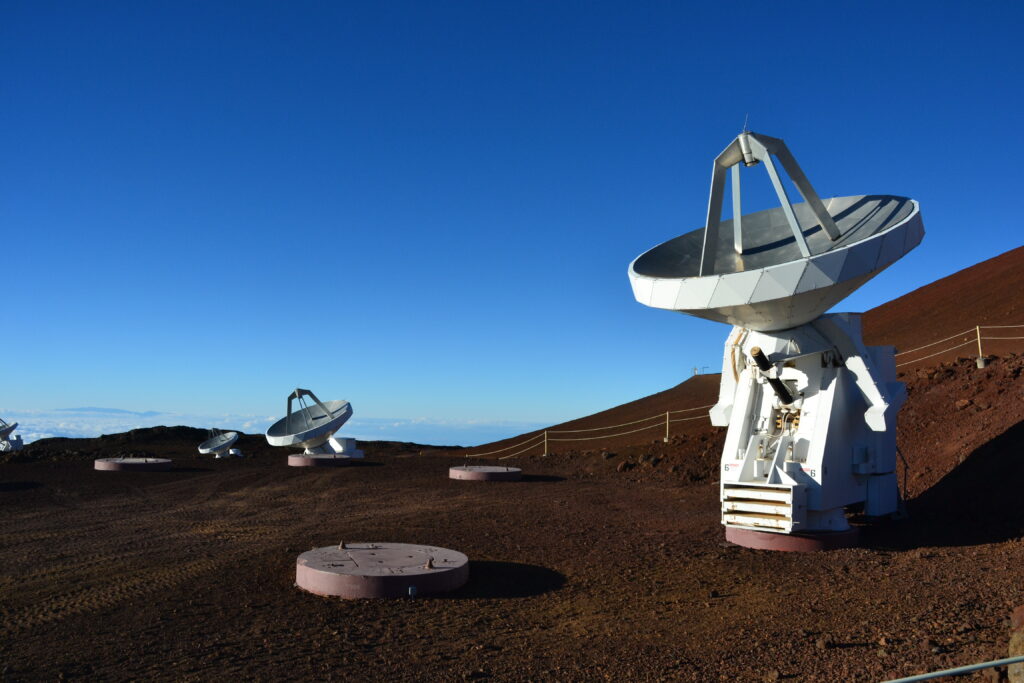
In 1968, the state granted a 65-year lease to the University of Hawaii to use land on Mauna Kea for astronomy (which ends in 2033). A mix of optical and radio telescopes on the peak represent efforts by scientists from 11 different countries, [3] efforts that include imaging the black hole at the center of our galaxy, [4] discovering a galaxy made almost entirely of dark matter, [5] examining habitable planets outside our solar system, [6] and even measuring the speed of cosmic expansion. [7] It is not an exaggeration to say that the contributions of the Mauna Kea observatories have been critical to our understanding of the universe.
Stage for Conflict
While the peak of this mountain may be figurative sacred ground to astronomers, it is literal sacred ground to native Hawaiians, who believe that it represents Earth’s umbilical cord from the heavens; where Earth Mother, Papa, meets Sky Father, Wākea; the point at which life begins, with Mauna Kea itself being the first born. [8] In ancient Hawaiian culture, access to the summit was restricted to priests and royalty, and it was not meant to be a place where anyone would stay for extended periods of time. But the land lease to the university eventually meant the influx of construction equipment, scientists, and 300,000 tourists a year (at least pre-pandemic), altering the land itself and who could access it.
Tensions escalated in recent years with the proposed construction of the Thirty Meter Telescope, an Extremely Large Telescope (yes, that’s actually a technical term [9]), consisting of 492 hexagonal mirrors, each 1.4 meters in diameter and arranged in the shape of a massive, thirty-meter-wide dish (as the name would suggest). Its increased capacity to capture light (along with some advanced optical systems) would make it nine times more powerful than the Keck Observatory, one of the other residents at the summit. [10] Mauna Kea was selected as the site in 2009 and permits were issued in 2011, but protesters interrupted the groundbreaking ceremony and subsequent construction in 2014. [11]
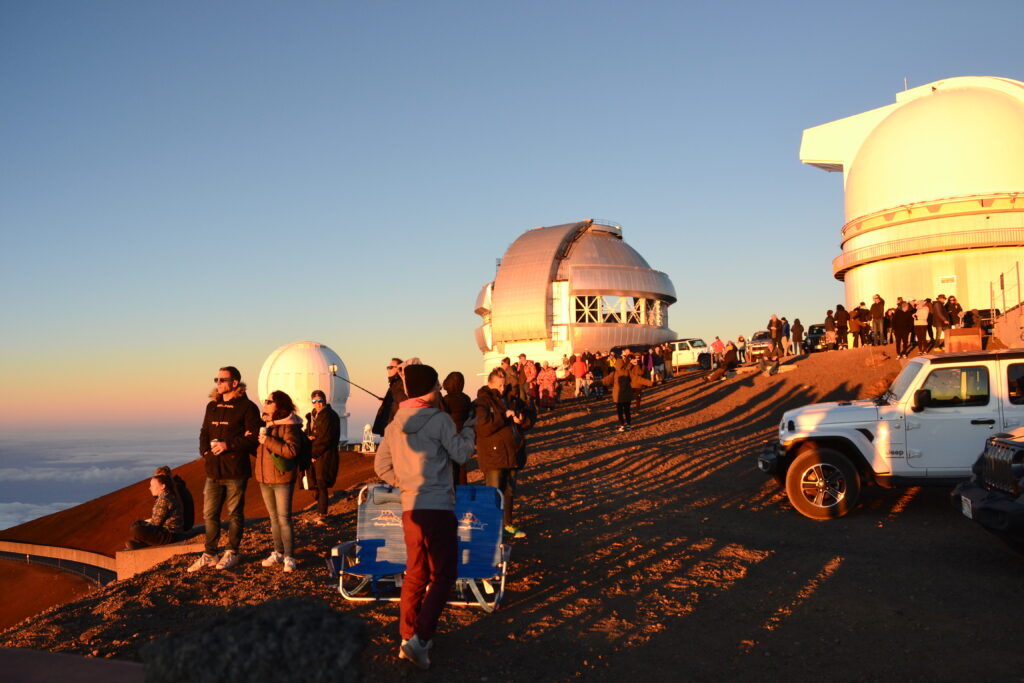
While the possibilities for astronomers are thrilling, the response from many in the native Hawaiian community was not positive, to say the least. Given the religious and cultural importance of the mauna, extensive protests took place over the course of several months, to the point that demonstrators established a daycare, cafeteria, and medical tent. The protests themselves gained the attention (and attendance) of several high-profile actors, including Jason Momoa. [12] News accounts of the conflict read as pretty dry material, but someone I know who lived in Hawai’i at the time said it was difficult to watch, especially since some of the police officers were tasked with arresting their own respected elders, creating painful rifts in nearby communities.
Stage for Resolution
Watching near the peak of Mauna Kea (only native Hawaiians are allowed to access the highest point on the mountain, and only for cultural practices), I was overcome with the stark beauty of the world at that elevation. We sat among a press of tourists, who fell silent as we watched the sun sink below the sea of clouds (except for one guy behind me who kept playing a new-age song on repeat while he got the perfect sunset video for social media). But sitting up there for that experience, I felt both the moving spiritual aspect of what I was witnessing AND the scientific admiration for the wonders of our natural world. Ever since I studied physics in college (and went to class with some deeply spiritual people), I’ve been aware that science and religion do not need to be mutually exclusive – at least in principle. Of course, conflicting priorities in practice can pose some difficulties.
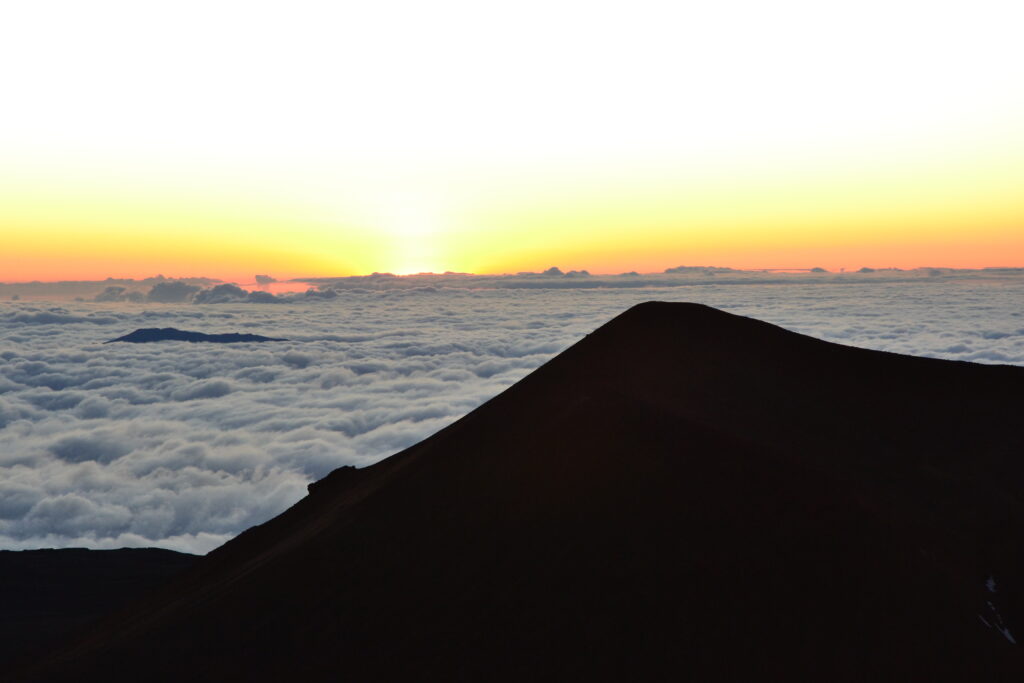
Interestingly, our tour guide mentioned that there was now an advisory group working to determine the future of scientific efforts on the mountain. The Mauna Kea Stewardship and Oversight Authority (MKSOA) was officially the result of state legislation in Hawai’i, but it got its roots in the early days of COVID-19. After almost 9 months of continuous protests, when construction workers and protestors alike left the mountain, discussions began to percolate between opposing factions. Those conversations grew and gathered momentum until the state itself established an end date for the University of Hawai’i’s responsibilities (2028) and the creation of an 11-member council, which would include “at least one practitioner of Native Hawaiian culture and one direct descendent of someone with knowledge of Mauna Kea traditions.” [13]
There is a long way to go, though it seems that a decision about the future of observatories on the mauna will have to be made by 2027 in order to either bring in more projects for the observatories or start winding down their research. Several members of MKSOA spoke at an astronomy conference in January 2023; the tenor of the panel seemed optimistic, and it appeared to be received well by most attendees. The associate director of Keck Observatory described their approach to consensus building and explained that they agreed to “put the mauna in the middle,” with individual human interests second. Since most people in the working group were born and raised in Hawai’i, that common ground has helped to build trust among the group. [14]
There is no guarantee at this point what will happen on the summit of Mauna Kea – whether astronomy will continue there, or whether it will be returned (as best as possible) to its natural state. Given my background in astronomy AND my background in environmental justice, I cannot say I’m necessarily rooting for any outcome 100%. I can say that I hope that this effort is meaningful and not performative, recognizes the perspectives and priorities of those involved, and that some common ground can be found at 13,800 feet. I will certainly be watching.
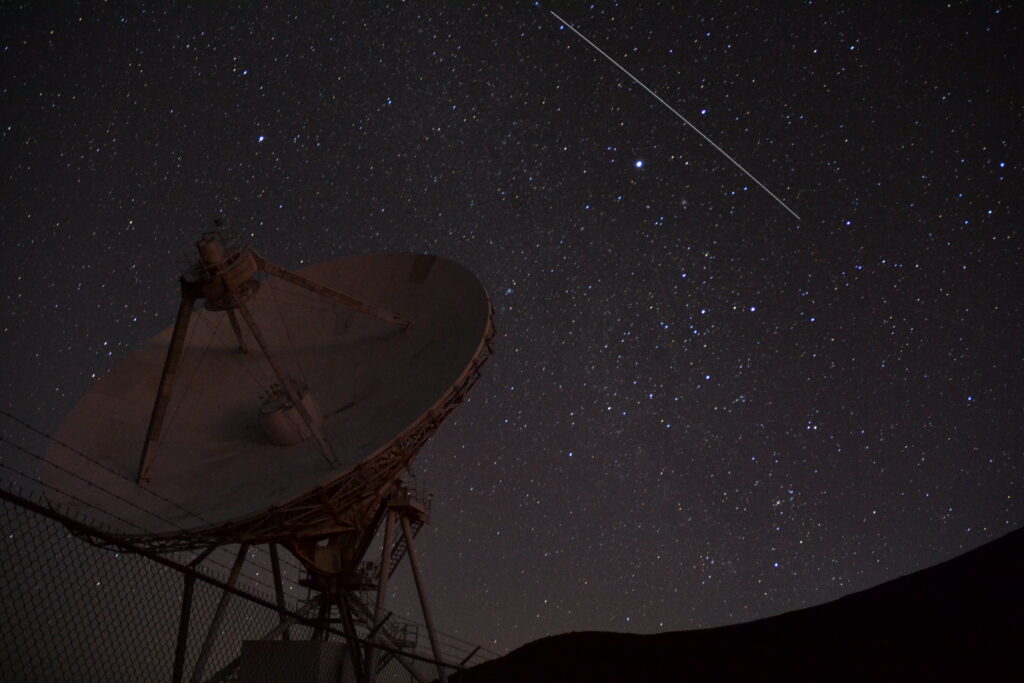
Although our Maui and Hawai’i visits were purely vacation time, themes from my climate lab program [16] kept percolating through as we encountered different situations, especially situations tied to tourist impacts and equity for residents. We returned home quite exhausted but full of new experiences and ways of looking at the world. If you have any thoughts or questions about any of these concepts, I’d love to hear them below.
Thanks for reading!
[1] https://www.nps.gov/articles/holo-mai-pele.htm
[2] https://www.nps.gov/havo/learn/nature/ahinahina-silverswords.htm
[3] https://about.ifa.hawaii.edu/facility/mauna-kea-observatories/
[5] https://www.space.com/33850-weird-galaxy-is-mostly-dark-matter.html
[6] https://www.nytimes.com/interactive/2016/10/03/science/hawaii-mauna-kea-telescope-discoveries.html
[7] https://www.nytimes.com/interactive/2016/10/03/science/hawaii-mauna-kea-telescope-discoveries.html
[8] https://www.npr.org/2022/07/31/1114314076/hawaii-mauna-kea-telescope-space-observatory
[9] https://en.wikipedia.org/wiki/Extremely_large_telescope
[10] https://www.tmt.org/
[11] https://en.wikipedia.org/wiki/Thirty_Meter_Telescope
[13] https://www.deseret.com/faith/2022/8/27/23323515/mauna-kea-telescope-debate
0 Comments